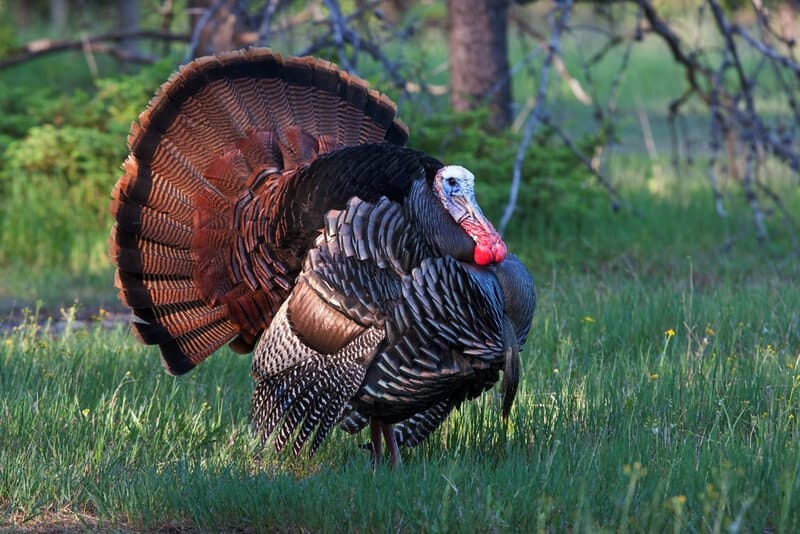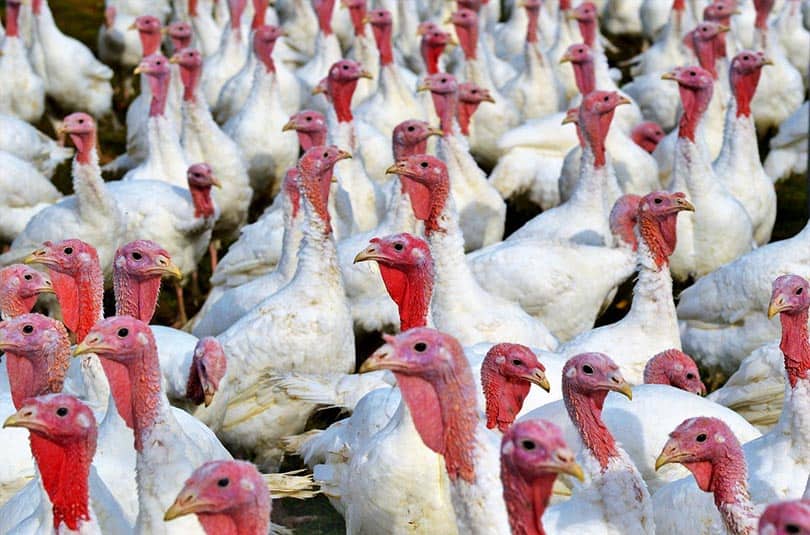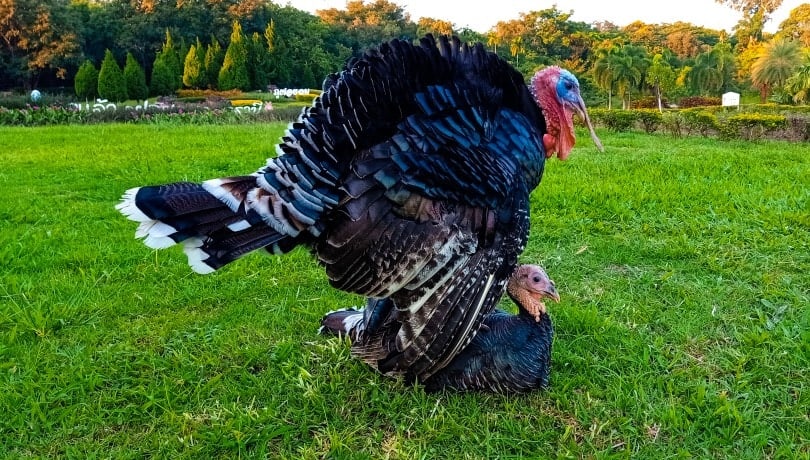In the wild, turkeys have quite the mating ritual that involves a pecking order, puffed-up feathers, and courtship dances. It’s a fascinating process that happens annually for wild turkeys.
On the other hand, domesticated turkeys have a different experience. They have a different build due to selective breeding, so they don’t participate in the same rituals as a wild turkey. We’ll discuss how each type of turkey mates and also answer frequently asked questions about their unique mating process.

How Do Turkeys Reproduce?
Male turkeys, or toms, reach sexual maturity when they are about 7 months old. Females, or hens, reach sexual maturity between 1-2 years old.
Interestingly, wild turkeys and domesticated turkeys are the same species: Meleagris gallopavo. However, they can have distinct behaviors and mating rituals.
Wild Turkeys

The mating season for wild turkeys depends on the subspecies of turkey, but they generally mate between late spring to early summer. You’ll know it’s the mating season when toms begin to display dominance and courtship rituals.
Since turkeys live in flocks, toms will start to size each other up, and even get into scuffles and fights. As they display dominance, they’ll start to separate and establish their own smaller flock of hens.
Toms will also begin to gobble loudly to attract the hens’ attention. Once he has his flock of hens, he will initiate his courtship dance. This dance consists of the tom spreading out his tail feathers and raising the feathers on his body. As he puffs himself up, he dances around the hen.
If the hen finds the tom interesting, she’ll position herself in front of him. After she’s in a crouching position, the tom will stand on top of the hen and mate.
Both toms and hens have cloacas, which is the opening that leads to their reproductive organs. Sperm transfers from the tom’s cloaca to the hen’s cloaca. This happens within minutes, and then the hen prepares herself to nest.
Turkeys are polygamous, so they mate with multiple partners. Dominant males do most of the mating, but less dominant males in the flock sometimes have opportunities to mate as well.
Domesticated Turkeys

The mating process is different for domesticated turkeys. Breeders used selective breeding to produce domestic turkeys with larger breasts. Therefore, unlike wild turkeys, most domestic turkeys can’t fly. Since they’re much heavier, they may even crush smaller hens if they try to mate.
Therefore, the most common method of mating domestic turkeys is artificial insemination. This is the safest and most efficient way to breed domestic turkeys.

Frequently Asked Questions
Now that we’ve covered the mating rituals and processes for both wild and domesticated turkeys, here are other factors that get included in their annual mating season.
How Many Times a Year Do Turkeys Breed?
Turkeys only breed once a year. A hen just has to mate once in order to produce a clutch of eggs. Once she lays her fertilized eggs, she usually won’t produce more fertilized eggs until the next mating season.
Toms usually mate with multiple partners. More dominant males can have around 10 partners during mating season.
How Long After Turkeys Mate Do They Lay Eggs?
Turkey hens can lay fertilized eggs as soon as the day after mating. She’ll look for a safe, well-hidden place to nest. Preferable nesting spots include thickets and underneath fallen trees. Turkeys are social creatures that live in flocks, so if you find a solitary hen in the springtime, it’s most likely that she’s looking for a nest.
A hen will lay one egg a day and usually lays between 9 to 13 eggs. Some can even lay up to 18 eggs. Hens can also double up and share a nest. These nests can hold around 30 eggs.
Once a hen lays all her eggs, it takes about 28 days for them to hatch. Even though the eggs get laid on separate days, hens sit on their eggs strategically to synchronize the hatching date. Therefore, most of them end up hatching within hours of each other.

Do Turkeys Have to Mate to Lay Eggs?
If a hen loses her clutch of eggs, she may try to re-nest. She doesn’t necessarily have to mate again because sperm from mating is able to fertilize eggs for up to 30 days. Therefore, if a hen has to re-nest shortly after she mated, she can lay more fertilized eggs without a tom.
Turkeys don’t have to mate to lay eggs throughout the year. However, these eggs aren’t fertilized. A hen can lay about two unfertilized eggs a week.
Related Read: 16 Fascinating & Fun Turkey Facts You Never Knew
How Do Turkeys Reproduce Asexually?
On rare occasions, hens can lay a fertilized egg without a tom. This phenomenon is called parthenogenesis and it can occur with other types of animals, such as sharks.
Predicting parthenogenesis is still unclear, but research shows that it can happen when a mate isn’t available. One study isolated turkey hens from toms, and the data showed that 16.3% of the eggs that the hens laid were fertilized eggs.
When an egg gets fertilized by parthenogenesis, the survival rate is extremely low, and most chicks are too weak to survive to adulthood. Also, when it comes to avian parthenogenesis, all the embryos end up being males.

Wrap Up
Wild turkeys definitely put on a show during mating season, especially when you compare them to domesticated turkeys. Female turkeys also undergo an interesting process after mating to ensure that their offspring have the best chance of survival.
Every once in a while, a female turkey can lay a fertilized egg without mating. These instances are very rare and often produce weaker chicks.
Overall, mating season for wild turkeys can be an interesting spectacle, and it’s always fun to catch a tom dancing around and pulling out all the stops to see which hens he can attract.
Featured Image Credit: Guppyfish, Shutterstock
